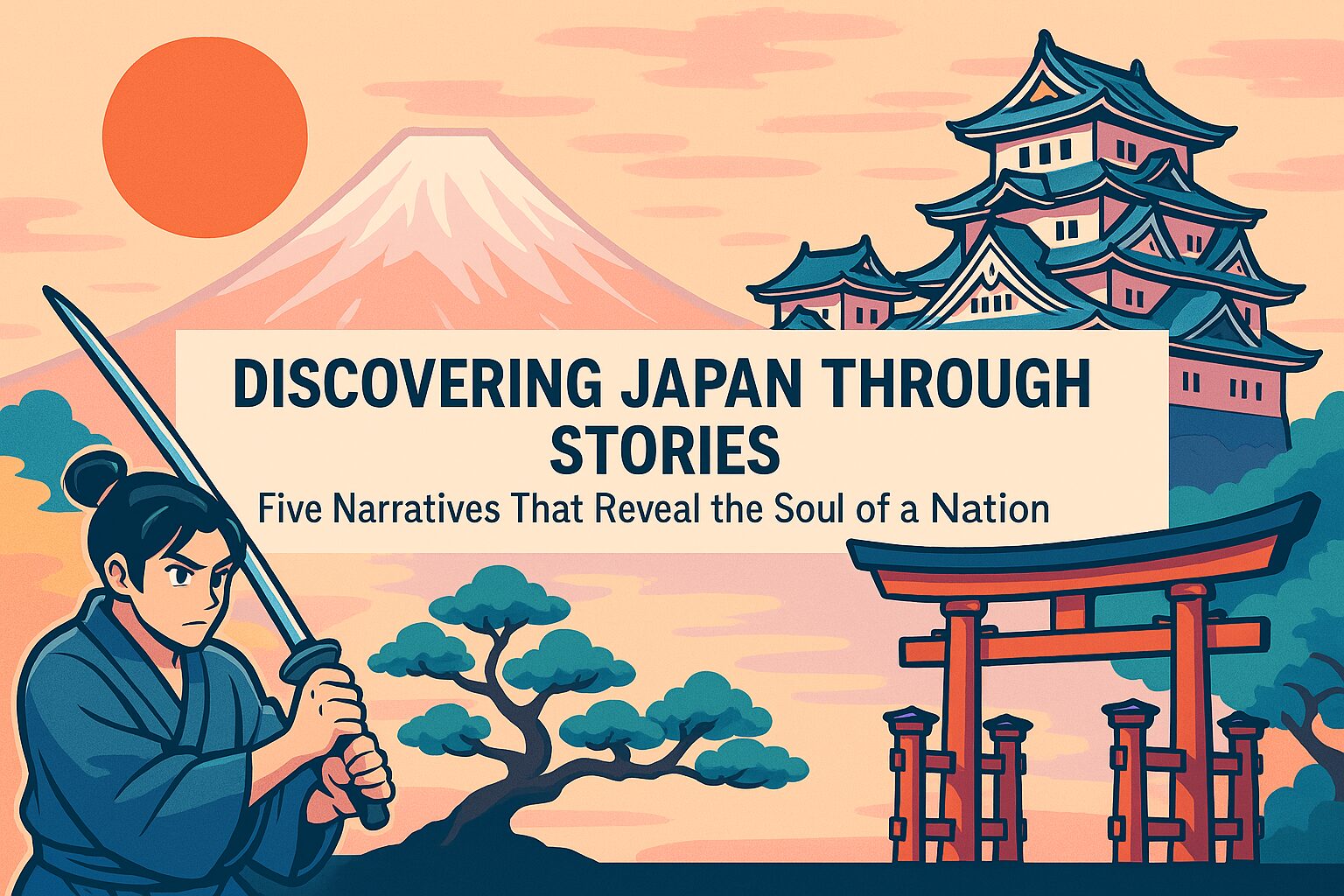Japan is a country where tradition and innovation coexist, where beauty often lies in impermanence, and where storytelling has long served as a window into its values and cultural identity. While temples and rituals might reflect visible aspects of Japan, it’s within its literature, anime, and historical drama that we truly grasp the nuances of its spirit. This article introduces five distinctive works that illuminate key Japanese values—honor, empathy, resilience, and aesthetic appreciation—and invites international readers to discover what makes Japan quietly profound.
- 🏯 1. The Tale of the Heike: The Elegy of Samurai Dignity
- 🗡️ 2. Rurouni Kenshin: The Sword That Chooses Peace
- 🕊️ 3. In This Corner of the World: Art, Loss, and Daily Grace
- 🎭 4. Nobunaga Concerto: Past Meets Future in a Samurai’s Shoes
- 🎶 5. Samurai Champloo: Remixing Edo with Hip-Hop
- 📝 Final Reflections: What Do These Stories Say About Japan?
🏯 1. The Tale of the Heike: The Elegy of Samurai Dignity
Among Japan’s oldest and most revered literary works, The Tale of the Heike offers not merely an account of war but a poetic meditation on the transience of life. Originating in the 13th century and passed down by biwa-playing monks, this epic recounts the rise and fall of the Heike clan. Its opening phrase, “The sound of the Gion Shōja bells echoes the impermanence of all things,” sets the tone for a story steeped in Buddhist philosophy.
The narrative unfolds across the Genpei War and culminates in the dramatic sea battle of Dannoura. But what makes this tale remarkable is its philosophical lens: warriors grapple with fate, pride, and loyalty, knowing their glory will inevitably fade. Far from glorifying conquest, the tale honors those who fall—the defeated whose dignity remains intact.
Even today, echoes of Heike resonate in Japan’s traditional arts. Noh plays, kabuki, and literature often revisit its themes, reflecting a culture that cherishes depth over triumph.
🗡️ 2. Rurouni Kenshin: The Sword That Chooses Peace
In stark contrast to medieval war tales, Rurouni Kenshin emerges from the vibrant world of manga and anime, yet its historical insight is equally profound. Set in the Meiji era—a time of dramatic modernization—it follows Himura Kenshin, a former assassin now devoted to a vow of non-killing. His weapon of choice, a reverse-blade sword, symbolizes his desire to protect without taking life.
As Kenshin navigates political upheaval and encounters enemies from his past, he represents a spiritual crossroads: the clash between bushido honor and modern humanist ethics. What’s compelling is how the story weaves redemption and personal growth into its narrative, echoing Japan’s own post-feudal transformation.
International viewers often come for the sword fights but stay for the emotional complexity. Kenshin’s journey challenges us to rethink justice, peace, and the power of restraint—a lesson that transcends borders.
🕊️ 3. In This Corner of the World: Art, Loss, and Daily Grace
In This Corner of the World brings us to Hiroshima during WWII, seen through the eyes of Suzu, a gentle and imaginative young woman. Her days are filled with small acts of resilience: cooking, sketching, and loving despite war’s harsh realities. The story doesn’t shout—it whispers. It shows that even under bombardment, beauty survives in the rhythm of ordinary life.
Unlike typical war narratives, this one centers on domestic scenes, seasonal changes, and subtle emotional shifts. Through Suzu’s eyes, viewers glimpse wabi-sabi, the Japanese aesthetic of imperfection and quietude. Her art becomes a way to see beyond destruction—a lifeline into meaning.
The film has won acclaim for its tender storytelling and cultural authenticity. For international audiences, it’s not just history—it’s humanity.
🎭 4. Nobunaga Concerto: Past Meets Future in a Samurai’s Shoes
What happens when a modern teenager wakes up in the Sengoku era and becomes Oda Nobunaga? Nobunaga Concerto answers this with humor, heart, and historical intrigue. Saburō, the unlikely hero, doesn’t understand feudal politics, but his honesty and unconventional thinking shift the tide of history.
While dramatized, the series cleverly juxtaposes traditional samurai expectations with contemporary values. Loyalty, marriage alliances, and warfare are challenged by empathy and innovation. It’s not just a fun premise—it asks deeper questions: Can one person change history by choosing understanding over aggression?
This fusion of past and present makes the story highly accessible to international readers. It’s a chance to meet Japan’s most famous warlord through a fresh lens—and to reflect on how old values adapt in modern times.
🎶 5. Samurai Champloo: Remixing Edo with Hip-Hop
Perhaps the boldest entry on our list, Samurai Champloo merges Edo-period aesthetics with hip-hop rhythms, creating an anachronistic journey that pulses with creativity. Three wanderers—Mugen, Jin, and Fuu—travel across Japan in search of a mysterious samurai. Along the way, they encounter corruption, beauty, and existential questions.
What sets this anime apart is its visual and musical hybridity. Breakdance-inspired sword fights, lo-fi beats by Nujabes, and themes of freedom echo through each episode. Yet beneath its edgy surface lie deep reflections on identity, honor, and emotional connection.
For international audiences, it serves as an invitation: Japanese culture is not static—it’s alive, remixable, and deeply expressive.
📝 Final Reflections: What Do These Stories Say About Japan?
These five works span centuries and styles, yet they all point to one truth—Japan expresses itself quietly, through subtlety, reflection, and emotional depth. Whether through ancient tales of doomed clans or modern anime explorations of peace and identity, the nation’s core values shine through.
Japan’s culture doesn’t demand attention—it invites it. And once we listen, we discover themes that resonate across borders: dignity in defeat, peace in adversity, and beauty in fleeting moments.



コメント